Re-experiencing Stories In Whole New and Thrilling Ways: An Interview with the Team Behind the Watership Down Graphic Novel Adaptation
Today’s post, I’m presenting to you something that has rarely happened on this site before. I suspect that for many of you, the idea of graphic novel adaptations of classic works of fiction is not unheard of. I’ve seen version of 1984, Kindred, Animal Farm, Brave New World, The Alchemist, and more over the years. Such books are released regularly, but rarely with the blessing of the books’ estates.
Today’s book is different. I was alerted to the following:
Watership Down: The Graphic Novel (Ten Speed Graphic | October 17, 2023| HC and Trade Paperback), by Richard Adamsis a beloved story of a group of rabbits on an epic journey in search of home. This classic tale of survival, hope, courage, and friendship has delighted and inspired readers around the world for more than fifty years. Masterfully adapted by award-winning author James Sturm and gorgeously illustrated by bestselling artist Joe Sutphin, this spectacular graphic novel will delight old fans and inspire new ones, bringing the joy of Watership Downto a new generation of readers.
More about the author: Richard Adams (May 9, 1920–December 24, 2016), an English veteran of World War II, originally told the story of Watership Down to his two daughters, who insisted he publish it as a book. It became an instant classic, selling over a million copies in both the United Kingdom and the United States, winning both the Carnegie Medal and the Guardian Children’s Fiction Prize in 1972.
Today I am interviewing James Sturm, who adapted Watership Down to a graphic novel format, along with artist Joe Sutphin. And just to make things particularly interesting, I am also interviewing Richard Adams’ daughters Juliet Johnson and Rosamond Mahony as well. But first, a glimpse of the book:
ADVERTISEMENT
ADVERTISEMENT
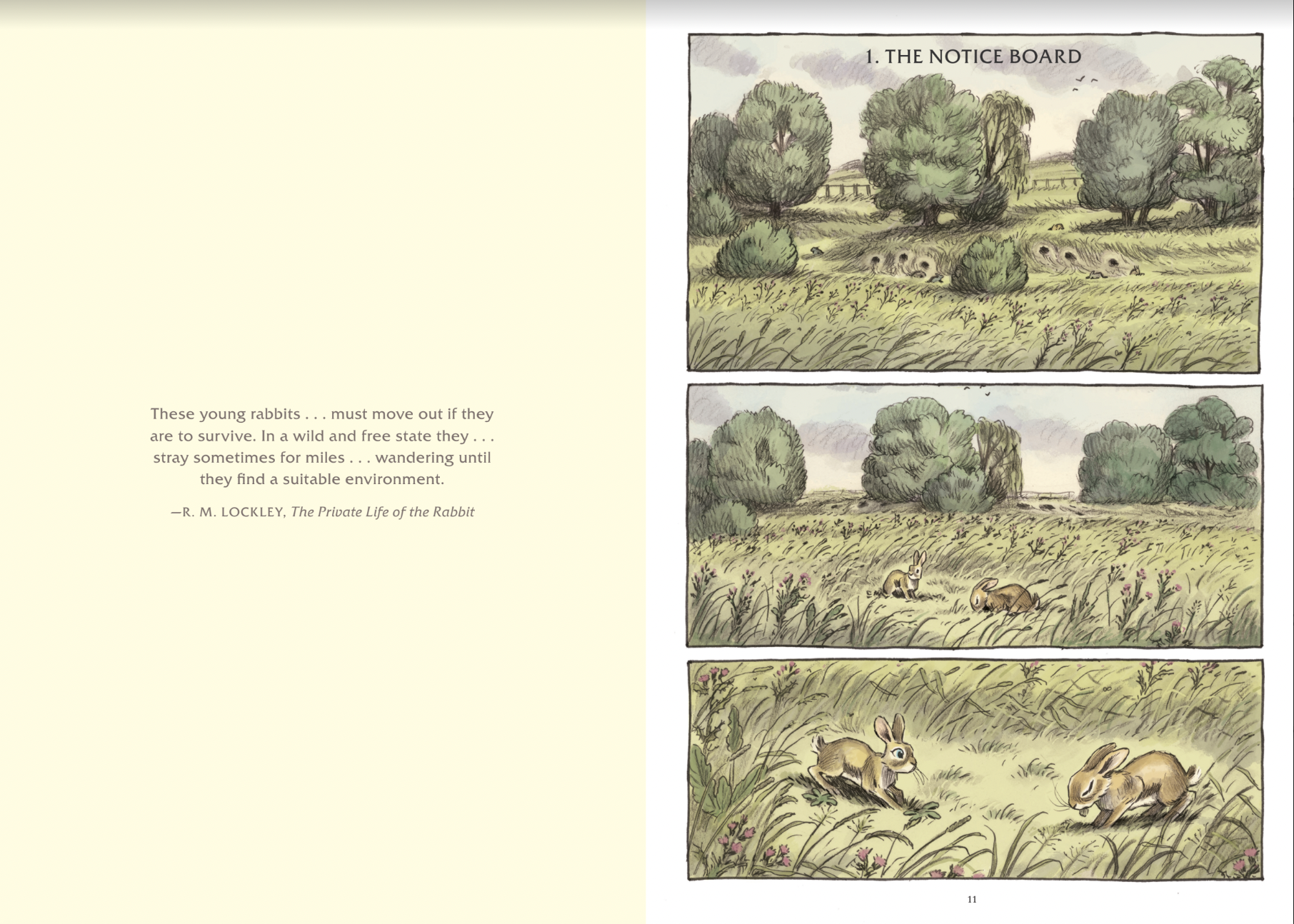
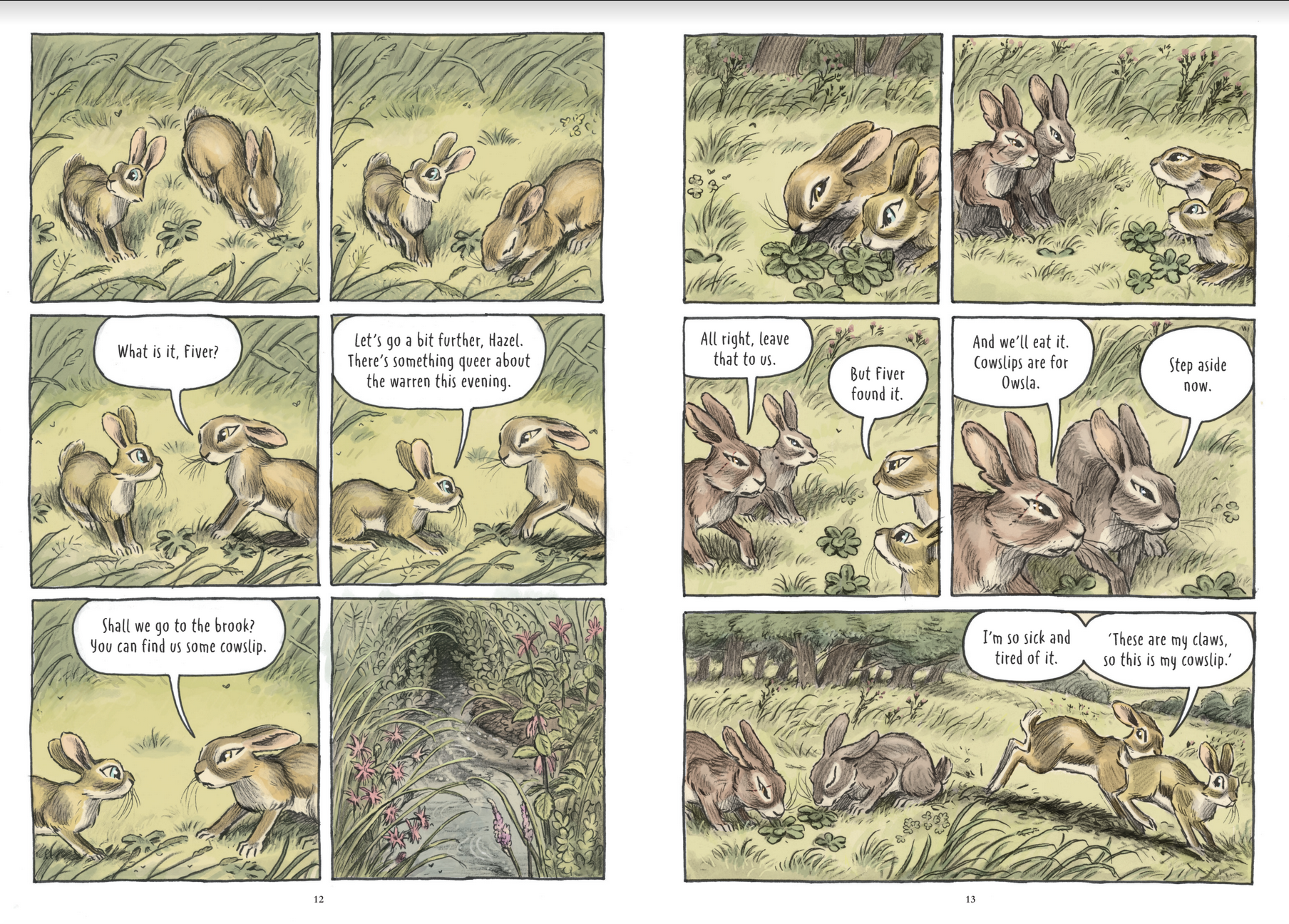

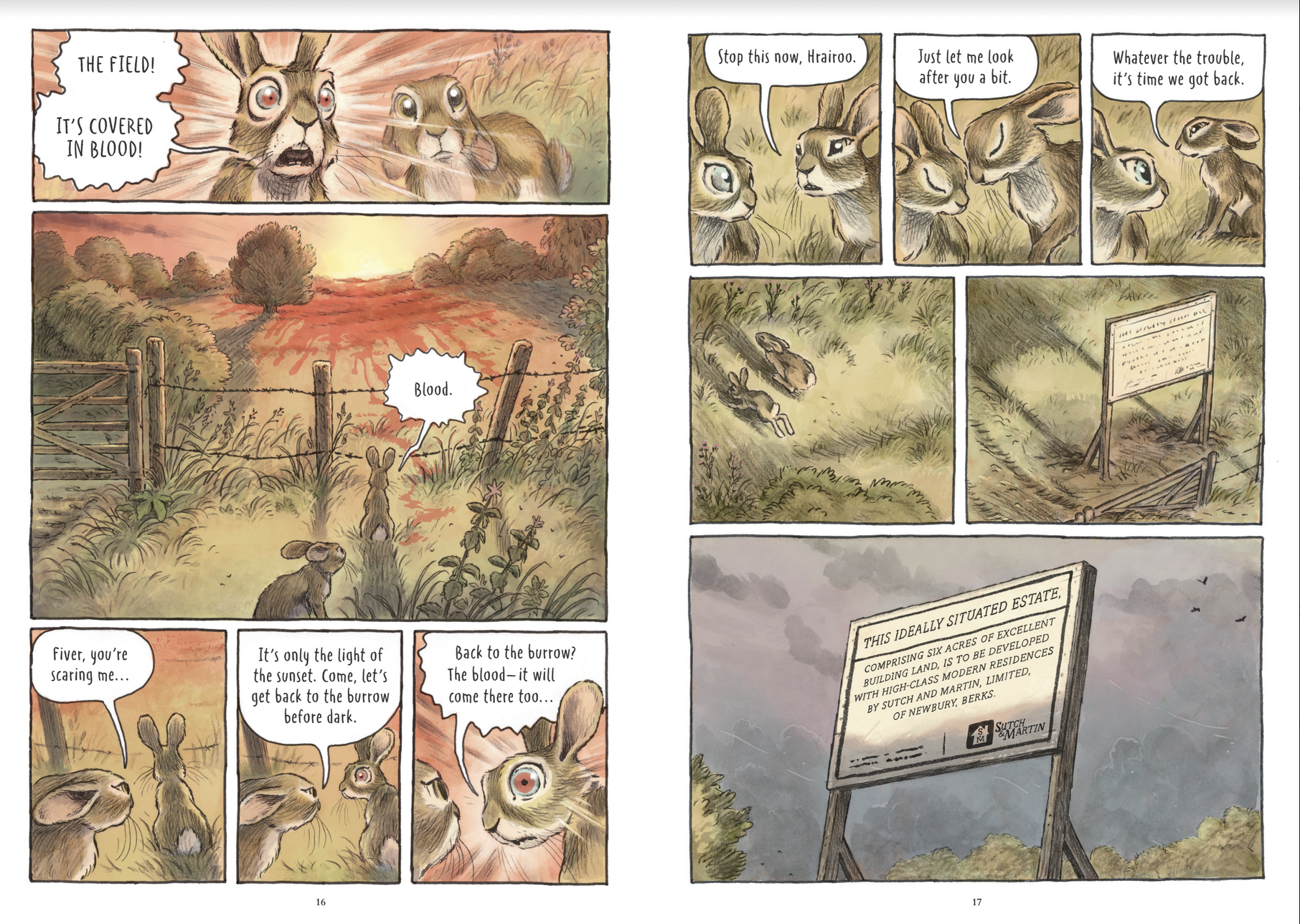
Betsy Bird: James Sturm, thank you so much for talking to me. First off, I wonder if you could tell me a little about your own personal connection to WATERSHIP DOWN. I know you came to it as an adult and not as a child. How did you come to discover it and how did it appeal to you?
James Sturm: I didn’t read Watership Down as a child in the 1970s even though there was a paperback copy in my house. At the time, I found the book baffling. What exactly is a watership? Why had it gone down? The cover illustration—an old-fashioned engraving of a compass and a rabbit—only added to my confusion. Plus at 448 pages, the book was intimidatingly long. I was much more interested in my Marvel comic books.
It took me thirty years to give the book another try. Ironically it turned out that Watership Down provided many of the same pleasures of those comics: indelible characters who each possessed different powers (speed, strength, leadership, clairvoyance) and formed a team (like The X-men or The Avengers) to fight bravely against a memorable villain (Woundwort). In the ensuing years, I read Watership Down out loud to each of my daughters and still later, assigned it to a class of graduate students at The Center for Cartoon Studies.
Betsy Bird: Who had the first idea of turning this into a graphic novel? As I understand it you were approached to adapt it with Joe Sutphin. How did that happen?
James Sturm: This project came to me via my agent, Judy Hansen. There aren’t many books I’d even consider adapting—this was one of them. To get the job I had to put together a proposal for the publisher and the estate. I reached out to Joe to see if he’d be interested. I had seen his work on Instagram and thought he could be a good fit.
Betsy Bird: I understand that you and Joe visited Juliet Johnson and Rosamond Mahony overseas. How did that come about?
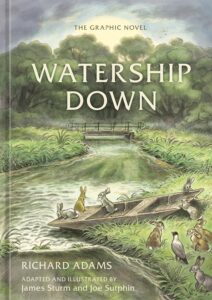
James Sturm: Even though the novel features a bunch of talking rabbits, Watership Down and every location in the book is an actual place. It was very important to the Adams’ estate that the book was rooted in that place. In England, we walked the same path as the rabbits and Joe and I took hundreds of photos. We also visited Richard’s grave while soaking up as many stories about Richard as his daughters were willing to share.
Betsy Bird: The level of coordination required for a project of this sort must have been massive. How did you keep up communication throughout? Was there a set timeline or did you play it by ear?
James Sturm: The Ten Speed team—especially editor Kaitlin Ketchum and designer Chloe Rawlins —were all-stars. They kept all the lines of communication open between the creative team, the estate, and the publisher. Big projects will always have challenges and Kaitlin and Chloe always stayed cool, calm, and supportive as we collectively figured out a way forward.
Betsy Bird: Amongst some of the blurbs for this book you got one from Tillie Walden (Clementine, etc.) saying that, “Graphic novel adaptations are notoriously difficult to do, but I will point to Watership Down as a beacon for how it should be done.” What were some of the challenges of this specific text when adapting it to a visual form? What were some of the hard choices you had to make?
James Sturm: The hardest part was finding that right balance of allowing the book to breathe and unfold in the unhurried way Adams writes while also compressing aspects of the book. Even at over 360 pages of comics we couldn’t include every element of the book. There were a few scenes here and there where I wish I could have lingered longer.
Betsy Bird: One choice made was to include several of the El-Ahrairah tales in the story. They break up the text nicely, but what was your own reasoning for including them?

James Sturm: How stories sustain us is a central element to Watership Down. The stories the rabbits share not only inspire them with tales of courage but often, as with the story of The King’s Lettuce, provide imaginative ideas that help them survive.
Betsy Bird: Finally, with any fiction to graphic novel adaptation, you’ll have the purists as well as the people who never read the original. What does this specific adaptation have in its favor in terms of bringing people to the original text?
James Sturm: Reading a graphic novel and reading a pictureless book are such totally different experiences. As mentioned in my personal connection to Watership Down, the original text may seem a little intimidating—especially to anyone who may struggle with reading for whatever reason. My hope is that people discover and love the more accessible graphic novel and then seek out the original text and reexperience the story in a whole new and thrilling way.
Betsy Bird: Joe Sutphin, thanks so much for talking to me too. I’d like to talk about the artwork you’ve created for this book, but before we get into any of that, I wonder if you could tell me a little bit about how you came to know WATERSHIP DOWN before this project?
Joe Sutphin: Thank you, Betsy. My earliest memory of Watership Down is the animated film from the 70’s. As a boy in the 1980’s, I would just flip through the channels on TV looking for something that didn’t look like boring adult programming. I have vivid memories of stumbling upon the animated film and having no understanding of it, yet being captivated by the characters and seriousness of it. I didn’t understand what the title meant, or what the rabbits were fighting for. It wouldn’t be until I was an adult, that I finally read the novel and grasped that there was far more beauty in Richard’s text than was ever depicted in that film. A decade ago, I became part of a creative community in Nashville called the Rabbit Room. Watership Down is a beloved story among that community, so it was a real honor to be entrusted to make this book, knowing that so many people I care about would get to enjoy it having been made by one of their friends.
Betsy Bird: I may be wildly off-base but I didn’t see that you’ve done a graphic novel adaptation of a classic text before. Watership Down is also a massive book to adapt. Even with the cuts you had to make, the final graphic novel clocks in at 384 pages. How long did this book take you to finish?

Joe Sutphin: That is correct. Although I made many comics for fun while growing up, I have not professionally made a graphic novel adaptation of any text at all. I did illustrate my own anthropomorphic edition of Little Pilgrim’s Progress simultaneously while working on Watership Down. Both of which were adaptations of classic works of fiction, but Watership Down took James and me the better part of 4.5 years to make. It was a true test of endurance, but that’s how good things come to be!
Betsy Bird: And how closely did you work with James Sturm throughout the process? Was there any back-and-forth or were you kept generally separate?
Joe Sutphin: James and I worked together at every stage of the journey. We dreamed together at the start. We traveled together in England, walking the fields and hills and roads together and getting to know each other closely. We spent many hours on the phone together, or texting, and just hearing each other’s ideas and vision for adapting the book. James absolutely embodies the true heart of cartooning, and I was tremendously blessed to have been mentored, guided, tutored by him, and then entrusted with making his storyboard my own. I can’t even conceive of a better cartoonist, or fan of Watership Down, to have adapted this book other than James. And I’m thrilled that I get to share in it with him, and that I gained a brother and a friend in the process.
Betsy Bird: Another challenge of a book of this sort is that its main characters are, for the most part, rabbits. It also has a huge cast, so visually distinguishing between these rabbits sounds impossible. How did you tackle the problem of helping the reader tell these characters apart?
Joe Sutphin: This was a true challenge indeed. James and I had many discussions about this. I wanted to be sure that I was going to first honor Richard’s text, and then lean into what I see in nature, and then add my own artistic sensibilities when designing the characters. I had come off of illustrating multiple rodent-themed novels, and I was not drawing good rabbits at that point. I had to get a lot of bad rabbit drawings out first. I became friends with someone who rehabilitates wild rabbits for the Ohio Wildlife Center, and she allowed me to come observe and sketch rabbits that were healing up in hutches and being prepared for release back into the wild. This gave me a great chance to study rabbits up close, learn how to draw their anatomy, and learn how each one can look different. I found ways to exaggerate features, come up with patterns on their fur, identifying marks and scars, scars on ear tips, or even just the roundness or squareness of a brow or muzzle could go a long way. And ultimately, I was able to come up with a lot of color variations with help from my pal Joe Hox who colored the book with me, to further differentiate the rabbits, and even help to group the various warrens together.
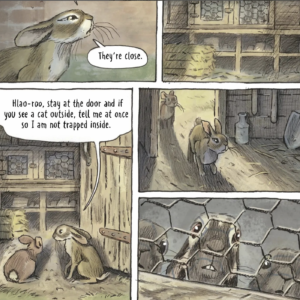
Betsy Bird: Could you tell us a little bit about the medium you used in creating this art? I love the difference between the realistic main story and the storytelling sections. How did you illustrate this?
Joe Sutphin: I started each page by penciling the page on Strathmore 400 Series 2-ply smooth Bristol. That was done on a light table with James’ rough thumbnails beneath. I then inked the page using a variety of Sakura Micron pens, followed by tonal work using sepia Prismacolor pencils which are just easy my eyes and won’t smudge like graphite. I then did a tonal wash over that using sepia Holbein Acryla Gouache, followed by washes of white gauche to add some atmosphere and distance in each panel. I fished them off with white pen highlights. My wife Gina scanned all 384 pages in, and I color corrected each one in Photoshop, dropped them into James’ master files with the text, and then began the digital watercolor process. In the final year of the project, Joe Hox came on board and I was able to show him exactly how I was coloring the book, and without a hitch he jumped in and ran with it. He did such a great job at replacing me, that when I look at the book I just see the vision we had all along. Joe is a dream to partner with.
Betsy Bird: Finally, early in the process I understand that you and James Sturm visited Juliet Johnson and Rosamond Mahony. You were also given a tour from artist Aldo Galli who worked with Richard Adams on an illustrated edition of the book back in the day. Could you tell us a little bit about that experience?
Joe Sutphin: What a treat that was. James and I spent the better part of a week at the Watership Down Inn, in Freefolk, and had plenty of time to wander the lands on our own, sketching the River Test and even randomly exiting a pasture and stumbling into the middle of a garden festival. It was excellent. Aldo Galli was close to Richard, and Richard passed a wealth of Watership Down knowledge on to Aldo. Aldo led our team (Juliet, Ros, KT Forster, James and I) through every field and hill, woods and copse, stream and river mentioned in Richard’s text. And at each stop, Aldo would pull out his tattered copy of Watership Down and read a passage that gave proof of what we were standing before. It was magical to say the least. Juliet and Ros shared so many fascinating stories with us as we walked along, often in the drizzling rain, just allowing us into their fold like dear friends or family. We had wonderfully intimate meals together in tiny countryside pubs, or quick stops to warm up with a flat white, and lots of time laughing together while driving from location to location, all soggy from the rain.
Betsy Bird: Finally, I have the pleaure of speaking with Richard Adams’ daughters. Julie Johnson and Rosamond Mahony, thank you both so much for talking with me. Before we talk about the current project, I wonder if you could tell me a little bit about what the book WATERSHIP DOWN means to you personally.

Rosamond Mahony: Watership Down means a great deal to me personally. It was written in 1966/67 so it speaks from a different time, but I think its messages about the destruction of the natural world resonate perhaps even more strongly today than they did at the time it was written. Daddy cared a great deal about nature and the environment and this book was written at a time of huge post-war change and in the midst of a great development boom. He saw much of the countryside he knew as a boy being developed and it saddened him. That was conveyed very strongly to us as children and it is something I still feel passionately about today. Watership Down speaks loudly and clearly about this and that is one of the reasons why many people love it. When I read his magnificent prose I can still hear daddy’s wonderful speaking voice – a fantastic legacy.
Betsy Bird: Could you tell me a little bit about how this particular project began for you? How were you approached about the idea of a graphic adaptation? And what did you initially think of the idea?
Juliet Johnson: This project was years in the making, and to be honest, we were a little bit nervous about it all. We wanted it to be a full and faithful adaptation of the original novel so knew that was going to be a huge task and needed a team who were experts in adaptation and illustration. We think we found it in James and Joe and all the team at Ten Speed Press.
Betsy Bird: I understand that you invited James Sturm and Joe Sutphin to England to visit some of the book’s locations. What was this experience like? What did you show them?
Rosamond Mahony: James and Joe came to England two years ago so that they could walk the Watership Down country and see the real places in the book. Their visit lasted about three days and we battled through some pretty awful weather! We visited all the main sites in the book including Sandleford where the original warren was, Newtown churchyard, Nuthanger Farm and of course Watership Down itself. They took many photographs of the country round about and the particular sites in question such as the railway arch and the river. They also photographed many plants and flowers so that they could draw them correctly for the book.

Betsy Bird: Finally, how do you feel about the final product?
Rosamond Mahony: I think the finished graphic novel is absolutely wonderful and Joe and James have worked so hard to make it authentic to the book. I think Daddy would have been delighted with the finished product. I certainly am. The illustrations are vibrant and colourful but also very accurate. It is not easy to convey characterization within the rabbit group and I think this has been captured very well. The rabbits all have their own characteristics and distinguishing features and it is quite easy to recognise which rabbit is which. I must say a huge well done to the author and artist.
In terms of thanks today, it’s hard to know where to start. I think I’ll have to begin with Maya Bradford and the folks at Ten Speed Graphic and Clarkson Potter for setting these interviews up in the first place. Thanks, most certainly, to James Sturm, Joe Sutphin, Juliet Johnson, and Rosamond Mahony. Watership Down: The Graphic Novel is out everywhere as of October 17, 2023 so be sure to get your early orders in now. Whether you’re an old fan or a new one, this is the book to read.
Filed under: Best Books, Best Books of 2023, Interviews
About Betsy Bird
Betsy Bird is currently the Collection Development Manager of the Evanston Public Library system and a former Materials Specialist for New York Public Library. She has served on Newbery, written for Horn Book, and has done other lovely little things that she'd love to tell you about but that she's sure you'd find more interesting to hear of in person. Her opinions are her own and do not reflect those of EPL, SLJ, or any of the other acronyms you might be able to name. Follow her on Twitter: @fuseeight.
ADVERTISEMENT
ADVERTISEMENT
SLJ Blog Network
Endangered Series #30: Nancy Drew
Review| Agents of S.U.I.T. 2
Navigating the High School and Academic Library Policy Landscape Around Dual Enrollment Students
MakerSpace: Dipping My Toes into Sublimation 101
ADVERTISEMENT








Oh thank you so much for this fascinating review!
Watership Down is my second favorite book in the world and I’m currently reading it to two of my granddaughters who are working through it.
I tried bribing some of the grandsons to listen to it but they couldn’t slog through all the boring plant stuff (which I actually think is important to the story). I even offered to pay them $30 each if they would. Nope.
Is the graphic novel unbowdlerized??? That is are the violent scenes in tact?
I have the movie from the ’70’s and it really didn’t do it justice. I’ve seen the mini series on Netflix and likewise.